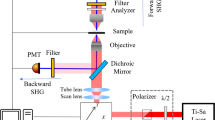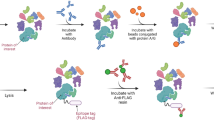Abstract
When and where proteins associate is a central question in many biomolecular studies. Förster resonance energy transfer (FRET) measurements can be used to address this question when the interacting proteins are labeled with appropriate donor and acceptor fluorophores. We describe an improved method to determine FRET efficiency that uses a mode-locked laser, a confocal microscope and a streak camera. We applied this method to study the association of α and β1 subunits of the human cardiac sodium channel. The subunits were tagged with the cyan and yellow variants of the green fluorescent protein (GFP) and expressed in human embryonic kidney (HEK293) cells. Pronounced FRET between the channel subunits in the endoplasmic reticulum (ER) suggested that the subunits associate before they reach the plasma membrane. The described method allows simultaneous measurement of donor and acceptor fluorescence decays and provides an intrinsically validated estimate of FRET efficiency.



Similar content being viewed by others
References
Catterall, W.A. Cellular and molecular biology of voltage-gated sodium channels. Physiol. Rev. 72, S15–S48 (1992).
Fozzard, H.A. & Hanck, D.A. Structure and function of voltage-dependent sodium channels: comparison of brain II and cardiac isoforms. Physiol. Rev. 72, 887–926 (1996).
Nuss, H.B., Chiamvimonvat, N., Perez-Garcia, M.T., Tomaselli, G.F. & Marban, E. Functional association of the β1 subunit with human cardiac (hH1) and rat skeletal muscle sodium channel a subunits expressed in Xenopus oocytes. J. Gen. Physiol. 106, 1171–1191 (1995).
Qu, Y. et al. Modulation of cardiac Na+ channel expression in Xenopus oocytes by β1 subunits. J. Biol. Chem. 270, 25696–25701 (1995).
Zimmer, T. et al. Functional expression of GFP-linked human heart sodium channel (hH1) and subcellular localization of the α subunit in HEK293 cells and dog cardiac myocytes. J. Membr. Biol. 186, 1–12 (2002).
Zimmer, T., Biskup, C., Bollensdorff, C. & Benndorf, K. The β1 subunit but not the β2 subunit colocalizes with the human heart Na+ channel (hH1) already within the endoplasmic reticulum. J. Membr. Biol. 186, 13–21 (2002).
Hink, M.A., Visser N.V., Borst, J.W., van Hoek, A. & Visser, A.J.W.G. Practical use of corrected fluorescence excitation and emission spectra of fluorescence proteins in Förster resonance energy transfer (FRET) studies. J. Fluoresc. 13, 185–188 (2003).
Tsien, R.Y. The green fluorescent protein. Annu. Rev. Biochem. 67, 509–544 (1998).
Malhotra, J.D. et al. Characterization of sodium channel α and β subunits in rat and mouse cardiac myocytes. Circulation 103, 1303–1310 (2001).
Kusumi, A. et al. Development of a streak-camera based time resolved microscope fluorimeter and its application to studies of membrane fusion in single cells. Biochemistry 30, 6517–6527 (1991).
Xu, X. et al. Detection of programmed cell death using fluorescence energy transfer. Nucleic Acids Res. 26, 2034–2035 (1998).
Clegg, R.M. Fluorescence resonance energy transfer. in Fluorescence Imaging Spectroscopy and Microscopy. (eds. Wang, X.F. & Herman, B.) 179–252 (John Wiley, New York, 1996).
Patterson, G.H., Piston, D.W. & Barisas, B.G. Förster distances between green fluorescent protein pairs. Anal. Biochem. 284, 438–440 (2000).
Acknowledgements
We thank U. Meisel, G. Möhler, U. Simon, G. Watzinger, G. Weiss and R. Wolleschensky (Carl Zeiss Jena GmbH) for their help in adapting the LSM to our needs. We also appreciate the support of U. Denzer and G. Rousseau (Hamamatsu Photonics Germany) for the installation of the streak camera setup. We are grateful to K. Schoknecht, A. Kolchmeier, S. Bernhardt, G. Ditze and A. Hertel for excellent technical assistance.
Author information
Authors and Affiliations
Corresponding authors
Ethics declarations
Competing interests
The authors declare no competing financial interests.
Rights and permissions
About this article
Cite this article
Biskup, C., Zimmer, T. & Benndorf, K. FRET between cardiac Na+ channel subunits measured with a confocal microscope and a streak camera. Nat Biotechnol 22, 220–224 (2004). https://doi.org/10.1038/nbt935
Received:
Accepted:
Published:
Issue Date:
DOI: https://doi.org/10.1038/nbt935
- Springer Nature America, Inc.
This article is cited by
-
Dual-ratiometric magnetic resonance tunable nanoprobe with acidic-microenvironment-responsive property to enhance the visualization of early tumor pathological changes
Nano Research (2023)
-
Simple phasor-based deep neural network for fluorescence lifetime imaging microscopy
Scientific Reports (2021)
-
Luminescence lifetime imaging of ultra-long room temperature phosphorescence on a smartphone
Analytical and Bioanalytical Chemistry (2021)
-
Two-way magnetic resonance tuning and enhanced subtraction imaging for non-invasive and quantitative biological imaging
Nature Nanotechnology (2020)





